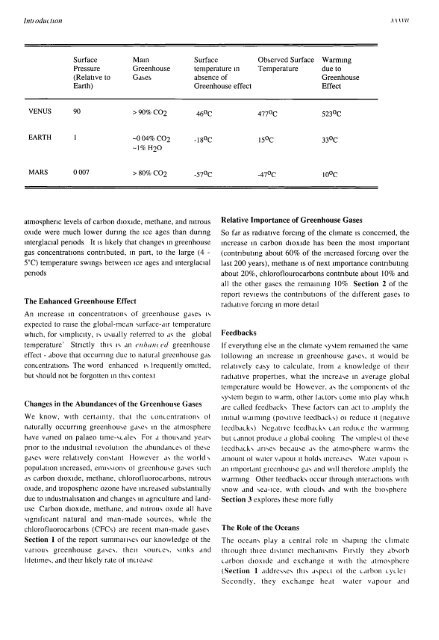First Assessment Report - IPCC
First Assessment Report - IPCC
First Assessment Report - IPCC
You also want an ePaper? Increase the reach of your titles
YUMPU automatically turns print PDFs into web optimized ePapers that Google loves.
Intioduttion<br />
WWII<br />
Surface<br />
Pressure<br />
(Relative to<br />
Earth)<br />
Main<br />
Greenhouse<br />
Gases<br />
Surface Observed Surface Warming<br />
temperature in Temperature due to<br />
absence of<br />
Greenhouse<br />
Greenhouse effect<br />
Effect<br />
VENUS<br />
90<br />
> 90% C02<br />
46°C<br />
477°C<br />
523°C<br />
EARTH<br />
1<br />
~0 04% C02<br />
~1%H20<br />
-18°C<br />
15°C<br />
33°C<br />
MARS 0 007 > 80% C02 -57°C -47°C 10°C<br />
atmospheric levels of carbon dioxide, methane, and nitrous<br />
oxide were much lower during the ice ages than during<br />
interglacial periods It is likely that changes in greenhouse<br />
gas concentrations contributed, in part, to the large (4 -<br />
5°C) temperature swings between ice ages and interglacial<br />
periods<br />
The Enhanced Greenhouse Effect<br />
An increase in concentrations of greenhouse gases is<br />
expected to raise the global-mean surface-air temperature<br />
which, for simplicity, is usually relerred to as the global<br />
temperature' Strictly this is an enhmu ed greenhouse<br />
effect - above that occurring due to natural greenhouse gas<br />
concentrations The word enhanced is frequently omitted,<br />
but should not be forgotten in this context<br />
Changes in the Abundances of the Greenhouse Gases<br />
We know, with certainty, that the concentrations of<br />
naturally occurring greenhouse gases in the atmosphere<br />
have varied on palaeo time-scales For a thousand years<br />
prior to the industrial ievolution the abundances of these<br />
gases were relatively constant However as the world s<br />
population increased, emissions of greenhouse gases such<br />
as carbon dioxide, methane, chlorofluorocarbons, nitrous<br />
oxide, and troposphenc ozone have increased substantially<br />
due to industrialisation and changes in agriculture and landuse<br />
Carbon dioxide, methane, and nitrous oxide all have<br />
significant natural and man-made sources, while the<br />
chlorofluorocarbons (CFCs) are recent man-made gases<br />
Section 1 of the report summanses our knowledge ot the<br />
various greenhouse gases, then sources, sinks and<br />
lifetimes, and their likely rate of inciease<br />
Relative Importance of Greenhouse Gases<br />
So far as radiative forcing of the climate is concerned, the<br />
increase in carbon dioxide has been the most important<br />
(contributing about 60% of the increased forcing over the<br />
last 200 years), methane is of next importance contributing<br />
about 20%, chloroflourocarbons contribute about 10% and<br />
all the other gases the remaining 10% Section 2 of the<br />
report reviews the contributions of the different gases to<br />
radiative forcing in more detail<br />
Feedbacks<br />
If everything else in the climate system remained the same<br />
following an increase in greenhouse gases, it would be<br />
relatively easy to calculate, from a knowledge of their<br />
radiative properties, what the increase in average global<br />
temperature would be However, as the components of the<br />
system begin to warm, other factors come into play which<br />
are called feedbacks These factors can act to amplify the<br />
initial wanning (positive feedbacks) oi reduce it (negative<br />
feedbacks) Negative feedbacks can reduce the warming<br />
but cannot produce a global cooling The simplest of these<br />
feedbacks arises because as the atmosphere warms the<br />
amount ol water vapoui it holds increases Watei vapoui is<br />
an important giccnhouse gas and will thereloie amphf) the<br />
warming Other feedbacks occur through interactions with<br />
snow and sea-ice, with clouds and with the biosphere<br />
Section 3 explores these more fully<br />
The Role of the Oceans<br />
The oceans play a central role in shaping the climate<br />
lluough thiee distinct mechanisms <strong>First</strong>ly they absorb<br />
carbon dioxide and exchange it with the atmosphere<br />
(Section 1 addresses this aspect of the carbon cycle)<br />
Secondly, they exchange heat water vapour and
















